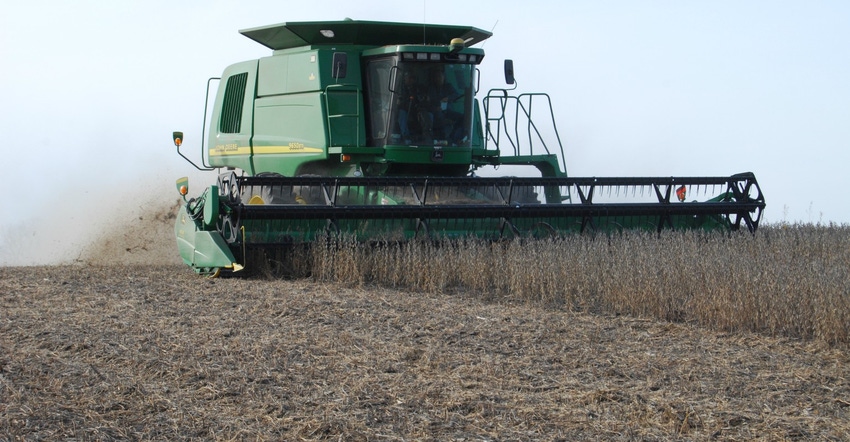October 8, 2019

The latest crop progress and conditions report for Iowa, released Oct. 7, shows 3% of Iowa’s corn crop has been harvested for grain, and 5% of the soybean crop. That’s 10 to 14 days behind the five-year average for this date.
Rain in September and now into October is causing issues for farmers in many areas of the state as they wait for fields to dry out enough to get in to harvest.
“It’s been one challenge after another this year,” says Morey Hill, farming near Madrid in central Iowa. “This feels a lot like last fall. It’s the same scenario. Here we are at the end of the first week of October and we are still waiting for fields to dry out to get machinery through.”
In eastern Iowa, Robb Ewoldt did some custom harvesting. Yields averaged 57 bushels per acre, about 10 bushels below what would normally be expected for those fields. “If you got shorted on rain in July, it affected the yield this year,” he says. He’s heard of bean yields ranging from 42 to 70 bushels per acre between Scott County and Clinton County.
In northeast Iowa near Plainfield, Rick Juchems started his soybean harvest before heavy rains came last week. He harvested a field that averaged 41 bushels per acre. “The beans were very small because of dry weather during time of pod fill,” Juchems says.
When the rain stops and it’s fit to harvest, these farmers will be ready. “Harvest 2019 is off to a slow start since much of the state received heavy rainfall last weekend,” notes Iowa Secretary of Agriculture Mike Naig. “We need several consecutive days of dry conditions and seasonal temperatures to give farmers time to make significant progress in their fields.”
The complete weekly Iowa Crop Progress and Condition Report is at nass.usda.gov
Crop report
Excessive rain throughout Iowa limited farmers to only 1.6 days suitable for fieldwork statewide during the week ending Oct. 6, according to USDA’s National Ag Statistics Service. Very little harvesting took place last week as farmers waited for field conditions to improve with drier weather.
Topsoil moisture was rated 0% very short, 2% short, 63% adequate and 35% surplus. Subsoil moisture was rated 0% very short, 3% short, 71% adequate and 26% surplus.
The survey shows 94% of Iowa’s corn crop has now reached dent stage or beyond, nearly three weeks behind last year and 16 days behind the five-year average. And 52% of the crop has reached maturity, three weeks behind last year and over two weeks behind average. Three percent of Iowa’s 2019 corn crop has been harvested for grain, two weeks behind average. Corn condition is rated 65% good-to-excellent.
For soybeans, the survey shows 92% of Iowa’s crop has begun coloring or beyond, two weeks behind last year and 10 days behind average. And 68% of the crop has begun dropping leaves, 15 days behind last year and 10 days behind average. Iowa has 5% of the soybean crop harvested, 12 days behind average. Soybean condition is rated 64% good-to-excellent.
The third cutting of alfalfa hay reached 90% complete, 18 days behind average. Pasture condition improved slightly from the previous week to 47% good-to-excellent. Feedlots remain muddy.
Weather report
Iowa had a very wet week as a stagnant pattern over the upper Midwest brought above-average rainfall across the entire state. Much of Iowa experienced unseasonable warmth, though cooler-than-average conditions were present in the state’s northwest corner. At the warmest, temperatures were 6 degrees above normal, with the statewide average temperature at 57.9 degrees, 1.5 degrees warmer than expected.
That’s the summary for the week ending Oct. 6. Justin Glisan, state climatologist at the Iowa Department of Agriculture, provides the following daily report.
Rain continued through the day on Sunday (Sept. 29) as a warm front moved north across Iowa. Daytime highs ranged from the mid-70s in southwest Iowa to mid-60s across northern Iowa. Monday was unseasonably warm with southerly winds and mostly sunny skies. Highs reached into the upper 80s with a few locations in the low 90s; the statewide average high was 86 degrees, 17 degrees warmer than normal.
Showers and thunderstorms moved through Iowa on Tuesday (Oct. 1) leaving multiple reports of severe weather. A weak, short-lived EF-0 rated tornado touched down in Shenandoah (Page County). There were also several reports of large hail in Polk County, varying in size from a quarter to a golf ball.
Northeast Iowa had severe straight-line winds as the front moved through during late evening. Rain was reported across most of Iowa, with 90 stations reporting over 2-inch totals and two stations in Poweshiek County reporting over 4 inches. Statewide average total was 1.31 inches.
Rain showers and a few thunderstorms moved through Iowa on Wednesday, leaving measurable amounts statewide. Totals were in the general range between 0.25 and 1 inch. Highs ranged from low-60s in the south to mid-50s in the north. As the system moved out, winds shifted to a northwesterly direction as a high-pressure center moved into the Midwest, creating cool conditions on Thursday. High temperatures were in the mid-50s to low-60s, with the average high of 57 degrees, 11 degrees below normal.
Friday remained cool under mostly sunny skies, with a light wind out of the east. High temperatures were in the mid-to-upper 50s, as much as 15 degrees below average.
Clouds began to stream in during the afternoon hours in advance of a cold front that brought thunderstorms into the state overnight into Saturday. The system cleared Iowa later in the day, with cloudy conditions keeping temperatures unseasonably cool. Rain totals at 7 a.m. on Sunday morning ranged from a trace in Mapleton (Monona County) to 1.72 inches in Clutier (Tama County). Over 20 stations reported over an inch, with the statewide average at 0.51 inch.
Weekly rain totals ran
About the Author(s)
You May Also Like






